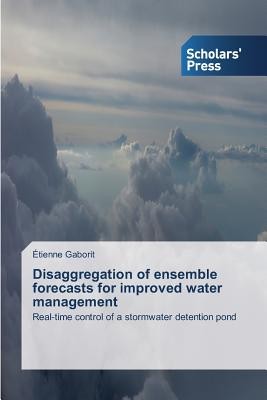
- We will send in 10–14 business days.
- Publisher: Scholars' Press
- Year: 2014
- Pages: 216
- ISBN-10: 3639704932
- ISBN-13: 9783639704938
- Format: 15.2 x 22.9 x 1.2 cm, softcover
- Language: English
- SAVE -10% with code: EXTRA
Disaggregation of ensemble forecasts for improved water management (e-book) (used book) | bookbook.eu
Reviews
Description
This research project demonstrates the interest of applying a spatial downscaling technique to ensemble rainfall forecasts from Environment Canada's Global Environmental Multiscale model (2009 version), and proposes innovative and effective real-time control strategies (sometimes relying on the downscaled forecasts) of an urban stormwater detention pond. Ensemble rainfall forecasts are indeed valuable in the field of water management for their explicit and dynamic assessment of the associated uncertainty. However, for hydrological forecasting, their low resolution currently limits their use to large watersheds. Therefore, this research project explores rendering the forecasts more appropriate for small catchments by bringing them from a 100 by 70-km resolution down to 6 by 4 km, using the method of Perica and Foufoula-Georgiou (1996). The downscaled forecasts are evaluated in three ways: comparing the rainfall amounts to observations, evaluating Hydrologic forecasts resulting from their use, and by assessing their interest when used for decision making, in this case by demonstrating that a stormwater detention pond's efficiency is improved when using the forecast information.
EXTRA 10 % discount with code: EXTRA
The promotion ends in 17d.04:22:16
The discount code is valid when purchasing from 10 €. Discounts do not stack.
- Publisher: Scholars' Press
- Year: 2014
- Pages: 216
- ISBN-10: 3639704932
- ISBN-13: 9783639704938
- Format: 15.2 x 22.9 x 1.2 cm, softcover
- Language: English English
This research project demonstrates the interest of applying a spatial downscaling technique to ensemble rainfall forecasts from Environment Canada's Global Environmental Multiscale model (2009 version), and proposes innovative and effective real-time control strategies (sometimes relying on the downscaled forecasts) of an urban stormwater detention pond. Ensemble rainfall forecasts are indeed valuable in the field of water management for their explicit and dynamic assessment of the associated uncertainty. However, for hydrological forecasting, their low resolution currently limits their use to large watersheds. Therefore, this research project explores rendering the forecasts more appropriate for small catchments by bringing them from a 100 by 70-km resolution down to 6 by 4 km, using the method of Perica and Foufoula-Georgiou (1996). The downscaled forecasts are evaluated in three ways: comparing the rainfall amounts to observations, evaluating Hydrologic forecasts resulting from their use, and by assessing their interest when used for decision making, in this case by demonstrating that a stormwater detention pond's efficiency is improved when using the forecast information.


Reviews